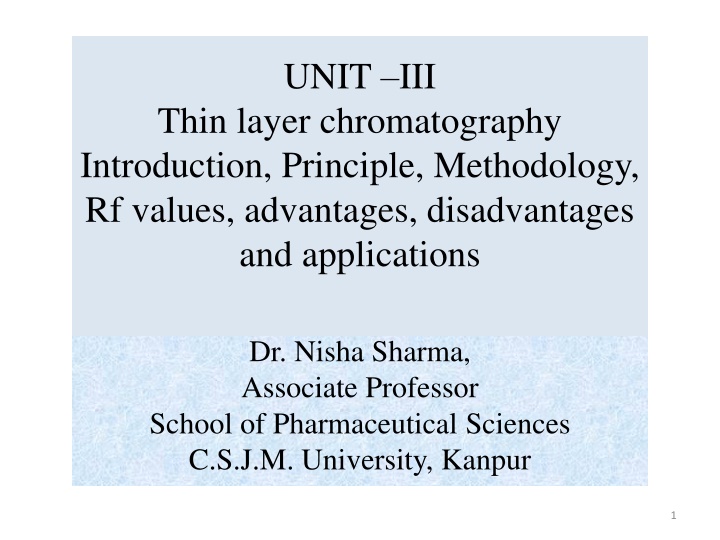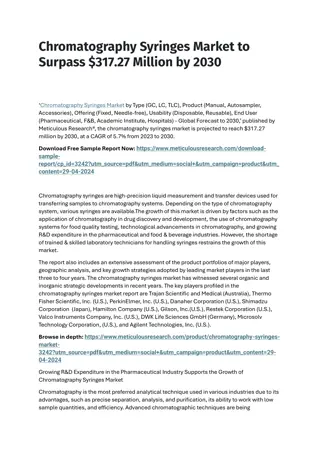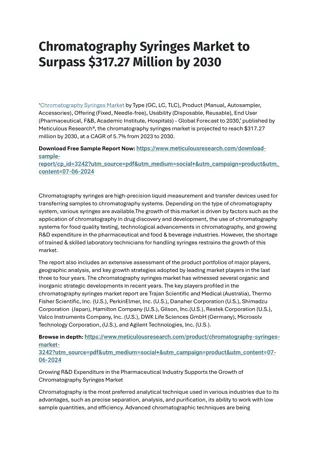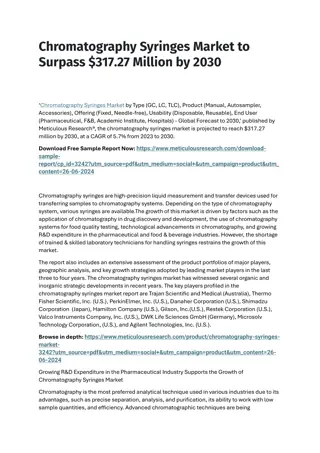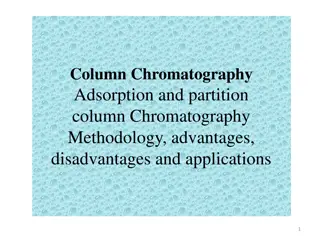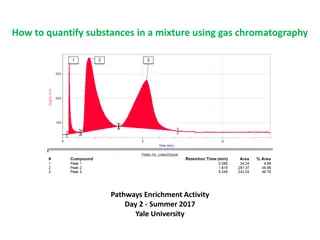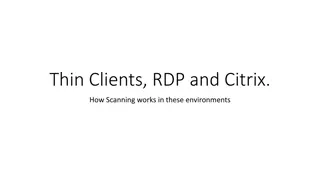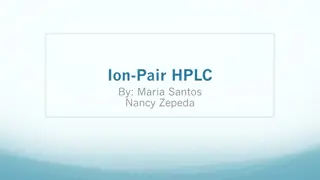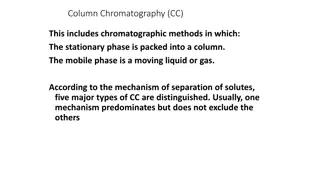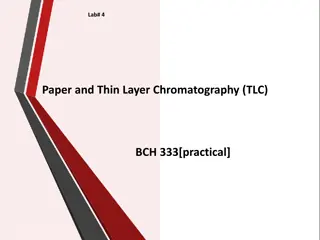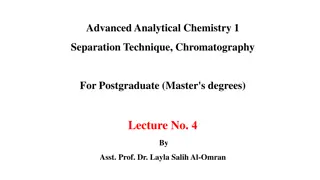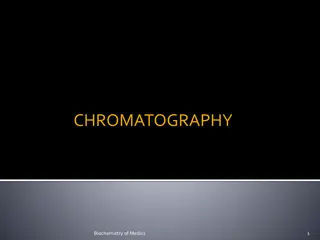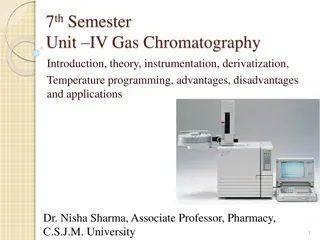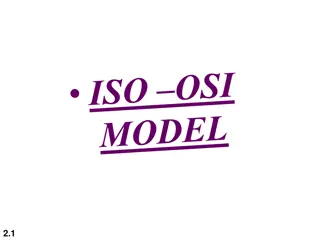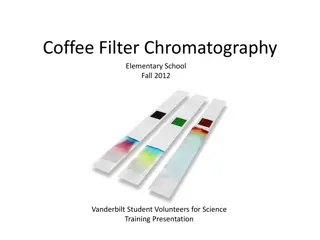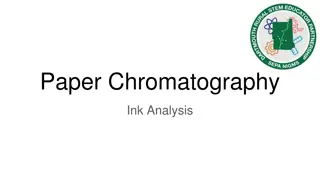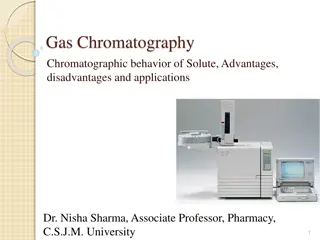Thin Layer Chromatography: Introduction, Principle, Methodology, and Applications
Thin Layer Chromatography (TLC) is a technique for separating and identifying compounds in a mixture based on adsorption. The principle involves the relative affinity of components to the stationary and mobile phases. The methodology is similar to paper chromatography, using coatings like silica gel or alumina on plates. TLC plates are prepared by various methods. The technique has advantages such as simplicity and speed, but drawbacks include limited resolution. It finds applications in analyzing plant extracts, identifying terpenes, and more.
Download Presentation

Please find below an Image/Link to download the presentation.
The content on the website is provided AS IS for your information and personal use only. It may not be sold, licensed, or shared on other websites without obtaining consent from the author.If you encounter any issues during the download, it is possible that the publisher has removed the file from their server.
You are allowed to download the files provided on this website for personal or commercial use, subject to the condition that they are used lawfully. All files are the property of their respective owners.
The content on the website is provided AS IS for your information and personal use only. It may not be sold, licensed, or shared on other websites without obtaining consent from the author.
E N D
Presentation Transcript
UNIT III Thin layer chromatography Introduction, Principle, Methodology, Rf values, advantages, disadvantages and applications Dr. Nisha Sharma, Associate Professor School of Pharmaceutical Sciences C.S.J.M. University, Kanpur 1
THIN LAYER CHROMATOGRAPHY M. Tsvet- Father of Liq. Chrom. 1900 s Introduced by Izmailov and Shraiber in 1938- separation of plant extracts Kirchner: 1950- coated plates- ident. terpenes E. Stahl in 1958 Designed equipment Also known as surface, strip, open column, spread layer chromatography 2
PRINCIPLE Based on separation by adsorption Depends on the relative affinity of components towards stationary and mobile phase Suppose, affinity of component A has strong towards adsorbent, then the movement will be less. Hence the different constituents separate. Liquid solid chromatography 3
PRINCIPLE Competition b/w molecules of analyte & solvent Both binds with the adsorbent surface Degree of retention depends upon: a. Binding strength of analyte with support b. Surface area of support c. Amount of mobile phase displaced by the analyte d. Binding strength of solvent phase to adsorbent 4
PRINCIPLE The retention may be affected by Electrostatic interactions Hydrogen bonding Dipole dipole interactions Van der-waals forces 5
Methodology Almost similar to paper chromatography 1. Coating material: Adsorbent Nature Activity Mechanism Substances Silica gel Acidic Active Adsorption/ Partition Adsorption/ partition Partition Acidic / neutral Alumina Basic Active Basic & neutral Keisulguhr Neutral Inactive St. hydrophilic subst Cellulose powder Neutral None Partition Water soluble compounds 6
Methodology Coating material: other examples: CaPO4, Mg Trisilicate, silica gel alumina (1:1), acetylated cellulose etc. Adsorbent : must adhere to plate Binders: CaSO4, starch, hydrated silica O Gypsum- widely used binder Ex: Silica gel G, Alumina G--- G stands for Gypsum Zinc silicate- inert fluorescent indicator Ex. Silica Gel GF 7
2. PREPARATION OF TLC PLATES Suspension of slurry is prepared Methods to prepare: a) Pouring method: back & forth b) Dipping: Peifer (1962)- 2 plates at a time- CHCl3 or CHCl3 MeOH c) Spraying: Reitsema Sprayer d) Spreading- applicator- aligning tray, spreader, developed by DESAGA (west G) 0.1-0.5 mm thick for analytical work 0.5-2 mm preparative work e) Precoated plates- ready to use- 0.1-0.2mm 8
3. Activation of Adsorbent: To remove liq. from TLC, Dry for 30min. in air, & then in oven at 110 C fro 30 min, For very active plates- 150 C- 4 hrs 4. Purification of silica gel G layers: To remove Iron as impurity, run plates in MeOH:HCl:: 9:1 v/v, Fe gets migrated to solvent front, again activate at 110 C, but if CaSO4 dissolves reused by adding Suitable binder 9
5. Sample application: Microsyringe Sample solution: non polar/ volatile solvent 6. Developing tank: tank + lid, saturation of tank is must, or lack of reproducibility in Rf 7. Solvent system: Stahl s triangle: better separation-mix. of solvents Ex: Ethyl acetate : methanol:: 99:1 Trial error basis best solvent system 10
Stahls triangle S E M 11
8. Development methods: Solvent allowed to rise at ht of 15-18cm on 20 cm plate, 20-40 minutes Solvent front marked and dried 9. Determination of components: Colorless--- U.V. Visualizing reagent Corrosive reagents chromic acid, H2SO4 10. Evaluation: Qualitative (R.f) Quantitative : Direct and indirect methods Direct: Visual, spot areas, densitometry, direct spectrometry Indirect: Elution- Instrumental 12
a b After 5 min After 15 min THIN LAYER CHROMATOGRAPHY sample a. Solvent front i.e. distance travelled by solvent b. Distance travelled by Sample 13
Saturation of TLC Tank Cover plate Thin layer plate Solvent wick for saturation Solvent mixture 14
Advantages Combines advantages of PC & CC Equipment simple Short development time compared to PC & CC Separation is fairly good on inorganic adsorbent material Wide choice of stationary phase- adsorption, partition, ion exchange 15
Advantages Fast recovery of separated components powdery coating of plate, scrapping, spot/ zone, quantitative removal, dissolve, spect./colorimeter Easy visualization of separated components, florescent compds. Detected easily under U.V. because inorganic background don t produce fluorescence 16
Advantages Sensitivity: Delineated, sharp spots, 10 to 100 folds as compared to PC Variable thickness of layers: Thin layers for qualitative and thicker layers for preparative Chemically inert stationary phase- application of strong heat or corrosive reagent like sulfuric acid Cost effective 17
Disadvantages Reproducible results are difficult Not automated procedure Only non volatile substance or subst. with low volatility can be separated Length of plate is limited Separation is in open system- humidity, temp. Quality of separation is limited 18
Applications Used for separation of all types of natural compounds To check the purity of samples As a purification process of isolated compd To examine the reaction: intermediate products To identify organic compds. As a check on process- progress of procedure 19
Applications Used for separation of inorganic ions- cationic, anionic, covalent species. organic deriv. of metals Sep. of vitamins Amino acids Sep. of alcohols, glycols, alkaloids, amines, proteins, antibiotics Used in all type of Industries, Medicine, Forensic science etc 20
References Jeffry G.H., J. Mendham et al. Vogel s Text book of Quantitative Chemical Analysis, 5th Edition, 1989, Longman Scientific & Technical, Bath Press, Great Britain. G.R. Chatwal, SK Anand. Instrumental methods of chemical analysis (Analytical Chemistry), ed. 1995, Himalaya Publishing House, Bombay. A.H. Beckett & J.B. Stenlake. Practical Pharmaceutcal Chemistry, Part Two, ed. 4th, 1997, (reprint 2003) CBS Publishers & Distributors, New Delhi. 21
